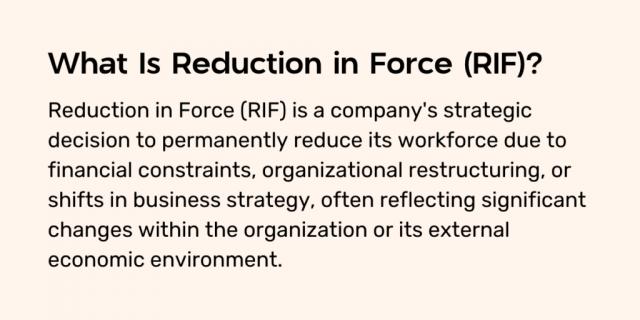What Is Reduction in Force?
Reduction in Force refers to the process a company undertakes to decrease its Workforce due to financial pressures, organizational restructuring, mergers or acquisitions, or changes in business strategy. Unlike layoffs, which might be temporary and allow for rehiring, RIF is often a permanent action, signifying a fundamental change in the organization. It’s a step taken not out of choice but necessity, reflecting deeper shifts within the company or its economic environment.
Major Drivers of Reduction in Force
Several factors can lead to a Reduction in Force, including:
- Economic downturns: Slumps in the economy can significantly affect a company’s revenue, prompting a reevaluation of staffing needs.
- Technological changes: Advances in technology might render certain jobs obsolete, necessitating a workforce adjustment.
- Business restructuring: Companies might need to realign their workforce to fit new business models or strategies.
- Mergers and acquisitions: The consolidation of companies often results in overlapping roles that require streamlining.
- Market competition: Intense competition may force companies to become more efficient, often through workforce reductions.
Understanding these drivers is crucial for HR professionals as it helps in anticipating potential RIF scenarios and preparing accordingly.
Alternatives to Reduction in Force
Before proceeding with RIF, it’s essential to consider alternatives that might mitigate the need for such drastic measures. These can include:
- Salary freezes or cuts: Temporarily halting salary increases or reducing salaries across the board can save costs.
- Voluntary leave or retirement: Offering incentives for voluntary resignation or early retirement can reduce the workforce amicably.
- Reduced work hours: Implementing part-time work schedules can lower payroll expenses without full job eliminations.
- Job sharing: Allowing two employees to share the responsibilities and salary of one full-time position can retain talent while reducing costs.
Exploring these alternatives can often provide a less disruptive solution to financial or strategic challenges.
How to Avoid Reductions in Force
Proactive measures can sometimes prevent the need for RIF. Strategies include:
- Regular workforce planning: Continuous assessment of workforce needs can help avoid overstaffing situations.
- Investment in employee development: Upskilling employees can make the workforce more adaptable to changing business needs.
- Efficiency improvements: Streamlining processes and improving productivity can reduce the need for a large workforce.
- Financial reserves: Maintaining a financial buffer can help weather economic downturns without resorting to workforce reductions.
While not always preventable, taking steps to minimize the likelihood of RIF can protect both employees and the company.
Key Issues in Managing a Reduction-In-Force
Managing RIF effectively involves navigating several critical issues:
- Legal compliance: Ensure adherence to labor laws and regulations to avoid legal repercussions.
- Fairness in selection: Criteria for RIF should be objective, transparent, and non-discriminatory.
- Support for affected employees: Offering severance packages, outplacement services, and emotional support can ease the transition for those impacted.
- Morale of remaining employees: Addressing the concerns and morale of the workforce that remains is crucial for maintaining productivity and engagement.
Addressing these issues thoughtfully can mitigate the negative impacts of RIF on both employees and the organization.
RIF Checklist for Strategy and Selection
Developing a RIF strategy requires careful planning and consideration. A checklist for HR professionals might include:
- Establish clear criteria for selection: Base decisions on objective performance metrics, business needs, and future company direction.
- Consult legal counsel: Ensure all plans comply with employment laws and regulations.
- Communicate with stakeholders: Keep leadership, managers, and employees informed throughout the process.
- Prepare support resources: Arrange for career counseling, resume workshops, and job placement assistance for affected employees.
Having a structured approach can help ensure a fair, respectful, and legally compliant RIF process.
Planning Reductions in Force (RIF) in Five Steps
A structured approach to planning RIF can include the following steps:
- Assessment: Evaluate the company’s financial health, workforce efficiency, and long-term goals to determine the need for RIF.
- Strategy Development: Formulate a RIF strategy that aligns with business objectives while minimizing negative impacts.
- Selection Criteria: Define clear, objective criteria for employee selection that adhere to legal standards and company values.
- Implementation Planning: Develop a detailed plan for executing the RIF, including timelines, communication strategies, and support services.
- Post-RIF Support: Plan for ongoing support
Conclusion
In conclusion, navigating a Reduction in Force (RIF) is a challenging yet crucial aspect of HR management, requiring a delicate balance between organizational needs and employee welfare. By understanding the drivers behind RIF, exploring alternatives, and implementing best practices for planning and communication, HR professionals can manage this difficult process with empathy and efficiency. Remember, the goal is not just to make tough decisions, but to do so in a way that respects the dignity of all involved and positions the organization for future success.

